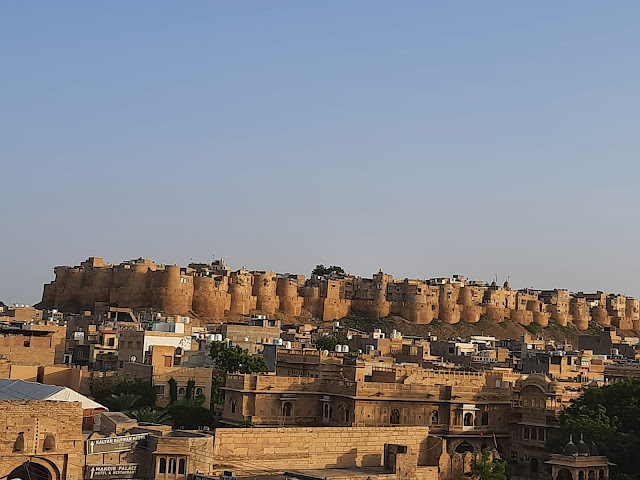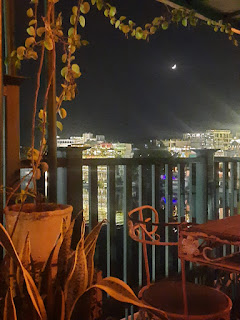A Commoner's Take on Jaisalmer's Legacy
For me, the essence of travel extends beyond lavish
stays and exotic food and ticking off famous landmarks. It's about delving into
the fabric of people, culture, and the nuanced backdrop that shapes a place.
Jaisalmer, renowned for its golden forts, havelis, arts and music, unfolded a
narrative far beyond the tourist brochures. Behind its grandeur lies a
captivating history, both intriguing and, at times, veiled in shadows. The
recent chapters, largely unknown, carry lessons worth unraveling. If you're one
to seek more than the surface, continue reading as I delve into a few
significant aspects.

Iconic Jaisalmer with Fort Backdrop
The Legend of Jaisalmer
According to the ancient myth, Rawal Jaisal, the visionary founder of Jaisalmer, was said to have been guided by a dream where Lord Krishna suggested establishing his kingdom atop the Trikuta Hill. Captivated by this divine counsel, Rawal Jaisal selected the Trikuta Hill as the site for his new fortress, giving birth to the iconic Jaisalmer Fort in 1156 AD.
Strategic Foothold
Maharawal Jaisal and His Illustrious Ancestors
Beyond mythology, Jaisalmer thrived at the heart of
the Thar Desert, strategically linking India to Persia, Egypt, Africa, and the
Western world. This made it a prosperous trading post, evident in landmarks
like the Jaisalmer Fort and ornate havelis. These structures stand testament to
Jaisalmer's enduring cultural and economic significance, reflecting the
grandeur of its past.
However, Jaisalmer's advantageous strategic location came at a cost, making it a coveted target for rulers and invaders alike. In the medieval period, the city confronted challenges from neighboring rulers and the formidable Mughal Empire. Yet, Jaisalmer's robust fortifications and clever positioning acted as a shield against multiple invasions. The Rajput rulers showcased remarkable valor and resilience in safeguarding their city against external threats.
Era of Regression
During the later medieval era, Jaisalmer encountered
a decline spurred by shifting trade routes, the rise of sea trade, and the
fading significance of traditional caravan routes. As maritime routes claimed
center stage, Jaisalmer's status as a major trading post waned, initiating an
economic downturn. Clash with neighboring regions and shifting political
landscapes compounded the city's challenges. The decline persisted into the
colonial period, with British influence reshaping trade and power dynamics. By
the time of independence, Jaisalmer had relinquished much of its former
economic and political glory.
Era After the Crown
Given its desert location, agriculture was never a viable source of income in Jaisalmer. Historically, the economy centered around royal activities, including employment in the army, courts, and engagement as artists (sculptors, performers). The production of goods required by the army, royalty, and merchants also played a significant role. With the dissolution of these traditional avenues, the people of Jaisalmer found themselves without straightforward means of earning a livelihood.
Aftermath of Partition
The 1947 partition had a significant impact on Jaisalmer. Proximity to the newly drawn border with Pakistan brought challenges and disruptions. Areas once integral to Jaisalmer's economic, agricultural, and cultural network were divided between India and Pakistan, leading to the closure of traditional trade routes and disturbance in economic ties. This geopolitical shift significantly hampered the city's economic activities, already facing challenges at the time. Descending into poverty, the people of Jaisalmer faced severe deprivation, grappling with hunger and water scarcity. This dire situation persisted for nearly 25 years until the 1971 war at the Longewala border, which garnered attention and marked the beginning of improvements for the region.
Wisdom In the Ruins
As I gather insights into significant periods in Jaisalmer's history, what lessons do I derive from it? Let's explore these points. You don't have to agree with them, and I'm open to any additional facts or thoughts you might have to counter-argue. I'm eager to learn and improve my understanding.
Price of liberty, a continuous reminder
Amidst the widely recognized accounts of thefts,
rapes, and murders during the partition, each border region holds its unique
and poignant narrative—a story of profound heartbreak. The bedrock of our
independence on August 15th rests on the shattered dreams of many, underscoring
the profound human cost of achieving freedom. As we celebrate our independence,
it is imperative to remember these untold stories, ensuring that our actions
moving forward do not inflict further harm upon the hard-won essence of freedom.
Societal Disparities Post-Royal Decline
In Jaisalmer, I noticed a stark contrast between the wealth of royal ancestors and the poverty of commoners post-decline. It seems that brave kings' predecessors moved forward without prioritizing commoners' welfare. While uncertain, I'm open to learning if conditions were different. A good king is revered for caring for the people. Figures like King Birendra Shah of Nepal, King Juan Carlos I of Spain, and King Mohammed VI of Morocco continued philanthropy post-royalty. If places like Jaisalmer were fortunate, they might have looked different.
Insights for the Multitude
In an ever-evolving world, it's unwise for commoners
to rely solely on the ruling bodies for well-being. Continuous self-improvement
while staying rooted in our values is essential—a challenging yet crucial
endeavor that deserves constant mindfulness.
In my anticipation to delve into Jaisalmer's local sights, desert adventures, and border experiences, an unexpected facet of this enchanting city has captured my attention. It insisted on taking the spotlight first, steering my focus away from the planned course. Please pardon this diversion as I succumb to the irresistible allure of Jaisalmer's hidden tales. The tales demanded immediate attention, and I promise to return promptly with the promised posts on local sights, the desert, and the border. Until then, stay tuned!


.jpeg)
Comments
Post a Comment